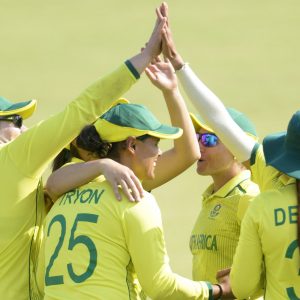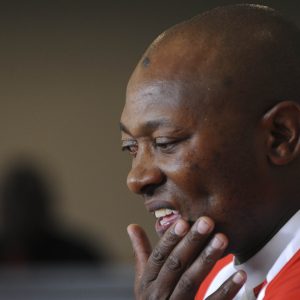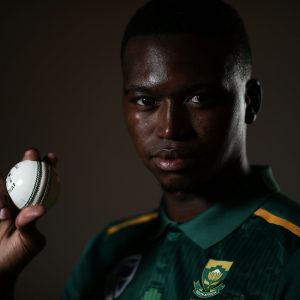Long Read | Part one: The start of CSA’s downfall
In the first of a three-part series, ousted Cricket South Africa chief executive Haroon Lorgat speaks about the implications of the poor decisions CSA made in 2017 regarding the T20 Global League.
Author:
12 October 2020

Picture, if your imagination can still stretch that far, a different 2020. Naturally, this fantasy world is free of politics or plunder, and there is no Covid-19 pandemic to turn everything on its head.
If you’re a cricketer, a fan or have anything to do with the game that currently lies in a state of despair, to dream is to momentarily escape the clutches of a reality that is increasingly too grim to contemplate. So, picture a late 2020 in which the never-to-be-seen T20 Global League is now in its third year. The initial broadcast and sponsorship deals have more than trebled in value, the annual window before Boxing Day Test cricket is reserved for Mzansi Time and there are international owners clamouring for an extension of franchises so they, too, can get in on the unique action.
As our imaginations are stretching recklessly, even India and Pakistan are at the South African negotiating table. Franchise owners from both countries joust regularly in the world’s premier Twenty20 cricket league, with Indian players donning the colours of the Benoni Zalmi or Durban Qalandars and a young Pakistani tearaway making hay for the Jozi Giants, owned by Delhi.
It’s a party trick triggered by South Africa’s relations with these countries, as well as their burgeoning status as cricket’s moral compass. But the country is not just reputation rich, it is flush from three years of compounding success. After all, the T20 Global League makes entertainment sense, but much, much more than that it makes a helluva lot of business cents.
The annual licensing for each team has swelled from the initial average of $4 million, depending on location, to a perfectly agreeable $10 million a year. And South Africa’s cricket authorities are about to launch a standalone Women’s Global League that sees young starlets from around the world earning good money.
Related article:
The Proteas and the Proteas Women have national contracts that allow them to at least contemplate not hiding injuries before the Indian Premier League (IPL) or international tours, because they now have worthwhile paydays. Development is structured to go from schools to amateur to the domestic franchise system, then the T20 Global League adds considerable sheen before South Africans roll off the production line, ready for the big time of international challenges, hardened by teammates from around the world showing them the way.
The coffers are healthier than ever and the stability in the game allows Cricket South Africa (CSA) to focus considerable effort on landing the unique double of the 2022 Women’s World Cup and then the 2023 World Cup for men. All things seem possible and touring South Africa for the end-of-year jaunt – which encompasses the Nedbank Golf Challenge, the Cape Town Sevens, the T20 Global League, a Boxing Day and a New Year’s cricket Test (never mind the safari, surf, culture and history that draws its own masses) – is now a massive lure for most Test nations.
How this utopia could have been realised
In 2017, the foundations were in place for this outrageously optimistic, imagined utopia. Incredibly, despite a now readily apparent culture of self-sabotage within the CSA, even then the owners had signed up, the best players were aligning their calendars and international juggernauts such as Emirates Airlines, India’s Hero MotoCorp (formerly Hero Honda) and Indian tyre manufacturer MRF had furnished the CSA with title sponsorship proposals.
SuperSport, once it had revisited its contract and found that clause 21.1 “expressly excluded any ICC event or league” from its understanding with the CSA, had rolled up its sleeves for a visit to the negotiation table. To open fresh discussions over the television broadcasting rights of the T20 Global League, SuperSport head of acquisitions and marketing Marc Jury flew from Johannesburg to Cape Town to meet then CSA chief executive Haroon Lorgat at the airport.
With him, Jury carried documents that outlined the broadcaster’s offer of R63 million a season to air the league’s matches. The CSA valued the rights at R100 million, but the willingness of both parties to thrash things out was an encouraging sign, especially after initial resistance.
It would have represented a watershed moment, too, as SuperSport traditionally held sway on matters of value and rights. This was a new market, with massive potential for all parties concerned.
Related article:
There was encouragement elsewhere, too. In his final week at the CSA, in late September 2017, Lorgat travelled to India to meet, among others, Star Sports, a group of Indian pay television sports channels, whose latest deal with the IPL is worth $2.55 billion over five years. In any world, real or imagined, South African cricket would snatch a fraction of that financial security.
In 2017, on Monday 25 September in Mumbai, the broadcast juggernaut’s chief executive, Uday Shankar, assured Lorgat of a letter of confirmation of Star Sports’ interest in the T20 Global League international rights by that Friday. Two days later, however, Lorgat was run out without so much as a review. He spent much of the day waiting on the outside, excluded from a meeting between the CSA board and the franchise owners at Bowmans, the law firm previously known as Bowman Gilfillan Africa Group that has increasingly become intimately entangled with the CSA’s affairs.
Lorgat was not allowed to take part in that meeting, and it was then that he made up his mind about his future, as the franchise owners were told how he was supposedly failing in his responsibilities to land the league as promised.
“It was surprising to see Mr Lorgat suddenly on the outside like that,” said would-be Durban Qalandars owner Sameen Rana from his home in Dubai. “As the owners, we were flown in for this very important meeting, but we all found it strange that it was held at a law firm that we had never heard of, when Cricket South Africa had their own facilities,” said Rana.
“Even the dinner that followed that evening was badly organised, at a time when we were supposed to be getting reassured that everything was still under control. The restaurant seemed surprised to see us, and there was a hastily prepared table for us to sit down to,” he added.

Disappointment at the death of the league
Rana looks back on the entire saga with regret and despair, because he knows the potential the tournament had. “The hardest part of trying to put together a tournament of this nature is getting the right owners. If you don’t get that, you will always be fixing issues. But the Global League had a great spread of respected and experienced owners within the franchise game, and they had contacts in India, Pakistan, Dubai, Singapore, the UK, Hong Kong and South Africa. You couldn’t really ask for more,” he said.
Once the owners come in with their money and influence, players, sponsors and broadcasters follow. It is a recipe that has been repeated successfully around the world, with varying degrees of success when used in conjunction with transparency and collective goodwill.
One consequence overlooked is the sincerity of investment that team owners were ready to lavish on this country, which they would have started calling their home away from home. The Qalandars, who operate as the Lahore Qalandars in the Pakistan Super League (PSL), were ready to roll out their development programmes across KwaZulu-Natal, providing the level of training and tutelage that turned social player Haris Rauf into a global star for franchise and country.
Related article:
Given that access to opportunities in disadvantaged areas remains one of South Africa’s biggest sporting obstacles, the scale of the Qalandars’ commitment – which was outlined to the KwaZulu-Natal government in 2017 – would have changed this dramatically.
What is more, significantly so, they would have done it all at their own expense. Rauf’s incredible rise from random to revered speaks to the dreams of many across South Africa, to know that a path to the top exists wherever there is talent.
“Personally, I have always loved South African cricket. It is a story that has always fascinated me. And the way that the country returned from isolation to compete so strongly, and still have so much untapped potential, is something that I wanted to help change with the Qalandars,” explained Rana.
“Some of my favourite cricketers of all time are South African and, if you look at the Qalandars in the PSL, there are so many South Africans that we have signed over the years. It is a land that I was very excited to be involved closely with, because there is just so much potential. We thought we could help discover the next AB de Villiers and Makhaya Ntini, with a programme that has already worked so well in Pakistan.
“In that meeting, we were told that Mr Haroon Lorgat had not been clear with the board, and there was no longer faith that he could finish the project. We were obviously concerned, because he had been our point of call since the beginning and we had no reason to doubt him. But if his employers had reasons, we had to believe that and get on with the show, as time was not on our side,” he said.
Lorgat and Nenzani’s relationship ends
“I remember the day clearly. It was Wednesday 27 September,” said Lorgat. It was the end of his relationship with CSA president Chris Nenzani, a shattering of the trust he says was established at the very first meeting.
“The first time I met Chris Nenzani privately was at the Intercontinental Hotel, back in 2013, the day before I was unveiled as the new CEO for Cricket South Africa,” Lorgat said. “Back then, I said to him that if ever there came a time when he felt that he couldn’t trust me, or that I felt I couldn’t trust him, then our journey together would be over.”
On that late afternoon in September 2017, Lorgat walked into the meeting with the board – the owners gone by then – and revisited that initial conversation with the CSA president, who tentatively remembered what had been said four years earlier. Lorgat says he made it quick, less than five minutes, pointing to the erosion of trust.
His departure was quickly followed by the postponement of the T20 Global League, a source of eternal embarrassment for South African cricket and the loss of millions of rands.
Lorgat was accused of not keeping the board updated on developments, including the status of the broadcast and sponsorship deals, as well as spending excessively, despite an operating budget of R100 million to get the tournament off the ground. Intriguingly, both Lorgat and his primary accusers had copies of documents that outlined a need for him to only update the board as deals were concluded, given the increasingly tight timelines involved.

New Frame has seen these documents and they shed a far more sinister light on the reasons the 2017 cricketing powers gave for Lorgat’s sudden departure.
A sticking point in the race to get the T20 Global League up and running was Nenzani’s stubborn refusal to allow Lorgat the leeway to employ a specific management team to build the league swiftly. Given the high stakes, it seemed a no-brainer.
Several attempts to contact Nenzani, who recently resigned as CSA president, were unsuccessful. And many key players in the 2017 saga are at odds with the CSA at present, meaning they cannot comment on what happened because of ongoing legal proceedings.
Related article:
Lorgat had drawn up a T20 Global League organogram, spearheaded by a general manager tasked solely with delivering the tournament on time. There would be a team below that general manager, including tournament director Russell Adams. He was the one appointment that was eventually made and announced to an increasingly pessimistic audience, one observing the promise of a league melting under the heat of international scrutiny – and, subsequently clear, internal interference.
Judging by the documents New Frame saw, there is a strong feeling that Lorgat’s untimely exit – and the dereliction domino effect that followed – could have been avoided. That is, if those who were still standing wanted him to stay. Personal issues in business are not unique to South African cricket. Some of the most significant partnerships in history have been forged on uneasy truces, with the common goal outweighing any private vendetta.
How the IPL got it right
The IPL’s first few seasons were rife with squabbles and positioning for power, but the collective will to get the greatest gravy train the game has ever seen off the platform – as scheduled – superseded any individual designs on influence. Even some dodgy passengers were granted initial access, their validation tickets to be scrutinised in due course.
If the CSA board had had that collective will in 2017, the intended T20 Global League could have moved forward with sponsors and a broadcast deal and, perhaps most importantly, the reputation of the country and its cricket governance intact.
Rana, who was still hopeful of a salvage after the botched 2017 effort, saw that time was up when he met with Thabang Moroe, the chief executive who was fired in August this year, in person. “He had absolutely no idea on how to run a tournament,” Rana said emphatically.
“He knew nothing. He tried to reassure myself and a few other owners about a 2018 tournament relaunch, but then couldn’t give us simple answers about which window they had identified. He had a concept of a floating tournament, which is just crazy in the modern game. You need to find a slot in the calendar and stay there, so players and sponsors can know what is happening.”
Related article:
CSA did offer to cover the costs that had been accrued by the owners in anticipation of the T20 Global League, but Rana maintains that the principle mattered more. Incredibly, he and fellow owners only heard about the league being cancelled through the media, despite essentially being shareholders with millions of dollars ready to be spent on the product.
It is richly ironic that, just a year later, the hastily rebranded Mzansi Super League only had a broadcast crew agreed and finalised the night before the first ball was bowled in Cape Town. The South African Broadcasting Corporation aired it for free, but there were no Lorgat-like repercussions for those in charge.
Quite what was to be gained from ousting Lorgat – as well as the expertise and recent experience that included putting together the PSL in Pakistan before he took charge of the CSA – is unclear. He had things in place, but not everything was signed. The promise of millions was tantalising, but that rich haul wasn’t in the bank yet. However it had happened, he was positioned as the face of the T20 Global League and the owners, potential partners and media all saw him as such.
Whether that elevated standing was a sore point within the organisation is difficult to know for sure. But interestingly, Nenzani had already told Lorgat privately that he saw Moroe as a future leader.
“Chris said he felt that Thabang was a great candidate to be the next CSA president. I told him that he was too young and inexperienced for that, but did say that I felt he had the makings of a CEO, who could lead for 10 years. I offered to work closer with him, as part of the preparation for that,” said Lorgat.
As it was, the machinations to hasten Moroe’s rise were already under way and Lorgat realised this too late.
Lessons learned by Lorgat
Looking back, Lorgat said there is only one thing he would change about 2017 and the start of the rapid decline of cricket governance in South Africa. “I would have ignored Chris’ insistence that we didn’t need to appoint a management team dealing with the Global League. That is my biggest regret, because trying to do that job of landing a tournament, as well as maintaining my CEO obligations, became an impossible task.”
When asked just before the end of his tenure what he might change during his time as CSA president, Nenzani said simply that he wouldn’t have extended his original term by another year. He did not mention the shambolic affairs of 2017, the effects of which the game in South Africa is still feeling to this day.
That was on Nenzani’s watch, and the game hasn’t forgotten.
Lorgat eventually walked, and with him went that pricelessly brittle thing called trust, particularly in matters compromised by a lack of time. By the end, there was little trust anywhere, especially for those outside the walls of the CSA.
“It was the most incredible thing. I mean, is there no accountability in your country?” Rana asked, almost helplessly.
Related article:
He and his company considered legal action against CSA, but thought better of it. There was little to be gained and their frustration would only build, he reasoned.
“I have business friends over there and I have asked them the same question. If Mr Lorgat had been found guilty, then he should have been rightly punished. But if the investigations showed that there was nothing wrong, then why did so many people, including those who forced Lorgat out, lose so much? Everybody was a loser in this. I just cannot understand it. What was the point?”
It is a question that keeps cropping up and as much as it was being bandied about in 2017, Rana’s question looms even larger today. A long, long way from the utopia that the T20 Global League promised – when CSA had money in the bank, sponsors on standby and a potential bounty on the horizon – it now stands with almost nothing in the bank, its sponsors have walked and even its latest broadcast deal with SuperSport is not yet sorted.
It is a shambles of the highest order.
“What was the point?” Rana and the rest of us ask.
In the second of this three-part series, New Frame investigates what led to the rash of sponsors walking out, members of the media being banned and the circumstances that led to Thabang Moroe being fired from the CSA.







